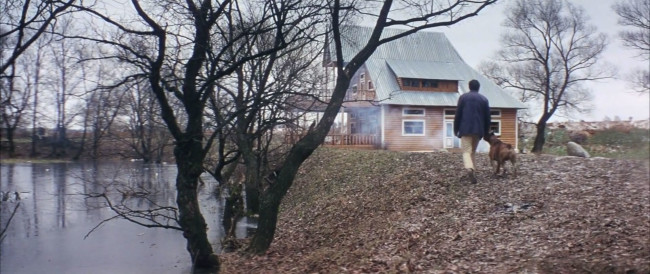
The film Solaris was based on the fantastic novel by Stanislaw Lem but there is no doubt that the film adaptation by Tarkovsky is much deeper and more interesting than the novel. The novel of Stanislaw Lem is more about the exploration of the cosmos and the film of Tarkovsky is more about the earth and humanity.
The film starts on earth with Tarkovsky’s views of nature on the land of Kris Kelvin’s father.
… Tall grass. Autumn leaves on a slow water surface. Distant song of a cuckoo. An unsaddled horse flashing past, clattering its hoofs. Rain, falling noisily outside the terrace, the moist garden, the spreading crown of oak, the family photos full of memories. You cannot become a man, not knowing love for your native land, not knowing love for your mother. Together with Kris try to understand the strange details of a winter morning, scattered on the convexity of the earth depicted on the painting by Pieter Bruegel. The brief footage captured of Earth is intimate, unique and poetic.
When the film appeared on the screen, followers of science fiction were writing about “the earth’s interpretation”‚ of the novel. Lem also did not like the movie because of that.
Of course in the novel Stanislaw Lem also deals with intellectual problems – being among the stars, waiting for the unknown was his “human” content. You cannot find contact with the ocean. But people on the ship are separated not only from the lack of understanding of the planet Solaris – they are fatally divided by their shameful thoughts and secret sins. And the woman who died on Earth and returns to Kris Kelvin by a strange game of nature, is literally made out of different matter – out of neutrinos: in a way it is the materialization of metaphor which was a psychological dilemma.
But Tarkovsky did not care about this issue. And Lem’s hero was not Kris Kelvin, for the author of the film the true heroine was Hari.
She materialized – at first only as an external shell.
In the beginning, at the station she is a “stranger” but she gradually becomes human.
Hari also learns the difficult art of conscience. What is reality if it is not of our own making? The more time she spends with Kelvin the more human she becomes. The more of her own experiences she is able to have the more she understands Kelvin. At one point she even says “I am becoming a human being,” suggesting at her own free will even though her inexplicable creation comes from the mind of another.
Human needs human and man needs earth – seems to be what the film is finally saying, even though it gives no clear suggestion as to what that ultimately means.
When man is happy, the meaning of life and other themes of eternity rarely interest him. These questions should be asked at the end of one’s life… The happiest people are those who never bother asking those cursed questions… To think about it is to know the day of one’s death. Not knowing that date makes us practically immortal.
Sartorius seems inhuman when he refers to Hari as a thing, something to be experimented upon, to be dissected, to be studied. Hari is, in many ways, more human than the emotionally inscrutable Sartorius. Her capacity for selfless sacrifice and unconditional love are manifestations of a real soul, and consequently, define her humanity. Though not innately human, she deserves to become one.
Kelvin remains in the middle: “We don’t know when our life will end, that’s why we’re in a hurry… We question life to seek out meaning. Yet to preserve all the simple human truths we need mysteries. The mystery of happiness, death, love.”
By the end of the film, Kelvin has stopped his questioning, desiring instead to return to a state of naive innocence. He only wants to love Hari. He wants to cleanse his memory of these questions, and retreat back home. Yet his home too becomes a literal island of memory on the surface of Solaris. The final scene has him kneeling before his father. Exactly like on the Rembrandt painting. Has communication really failed? Should we turn around and go back if we do not find what we expected on our ”trip” towards unknown? As the price sometimes seems too high, is it okay for us just to give up and to sleep within the dream?

Hunters in the Snow by Pieter Bruegel the Elder
When creating his masterpiece, the Solaris director Andrei Tarkovsky constructed the narration using an inter-circulation of pieces belonging to diverse non-cinematic art-dimensions: music and painting. Music by Bach and paintings by Bruegel create a unique atmosphere and rhythm for the film. These citations mark significant moments of the film. Tarkovsky’s cinematic technique represents his ability to reflect meaning with the help of metaphorisation and to set up a multidimensional vision of a subject.
Tarkovsky was a truly humanistic mind who managed to write a new chapter in the history of cinema.
Solaris is an exploration of humanity, a journey to extend the territorial bounds of man, only to find the planet of his own consciousness.
In a society driven to explore the universe, the ocean of Solaris provides the space for probing the deepest regions of the human soul. But inevitably, the Truth proves to be as elusive as the thinly veiled reality of Solaris: The question is unanswered, can a man truly reconcile with his past, or is he destined to be bound to guilt and regret?
